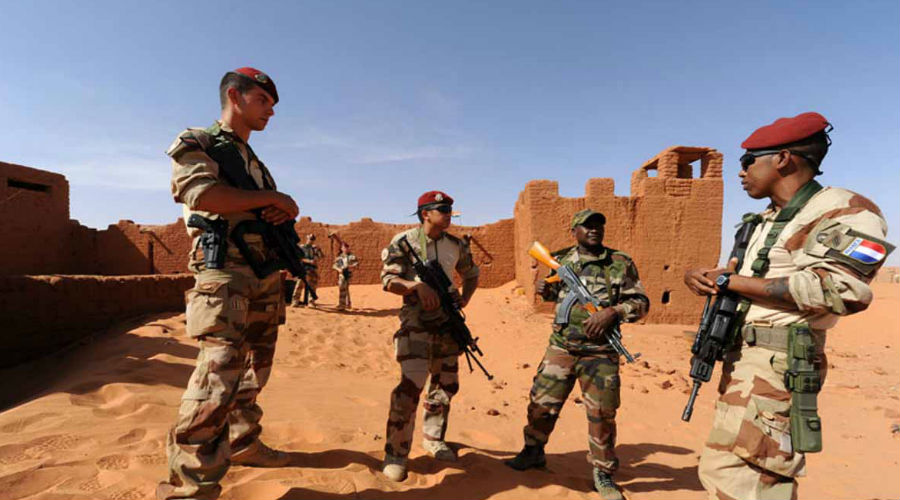Mounting threats posed by terrorist organizations forced the states of the Sahel and Sahara region to create a joint military force to address the issue, with support from France. On September 10, Malian President Ibrahim Boubacar Keita opened the headquarters of the 5,000-strong Group of Five Sahel (G5 Sahel) Joint Force which includes troops from Mali, Niger, Chad, Burkina Faso and Mauritania, and will be operational along Mali’s border with Niger and Burkina Faso by October.
The development is especially important because of the timing. The launch of the multinational force coincides with the possibility that some terrorist elements would move to the African region following huge losses suffered by ISIS in both Syria and Iraq, posing negative repercussions for the security and stability of the five western-African states.
The creation of the G5 Sahel force also reflects France's interest in supporting the effort through urging the involved states to take action to activate the force and promote their security and military cooperation and coordination and combat terrorist organizations.
Multiple Obstacles
Despite the importance of creating it in the Sahel and Sahara with the aim of countering the spread of terrorist organizations, it cannot be denied that the new anti-terror force is likely to face no easy challenges that can be summarized as follows:
1- Multiplicity of Terror Organizations. Some of these organizations recently sought to escalate their activity in the Sahel and Sahara and recruit as many local elements as possible.
To this end, some of these organizations allied formed alliances. The Sahara Emirate and the Al-Mourabitoun (The Sentinels) group and the Macina Liberation Movement merged into one group now called the Jamaat Nusrat al-Islam wal Muslimeen (Support of Islam and Muslims) under the leadership of Iyad Ag Ghaly, the former leader of Ansar Dine.
It should be noted that the new alliance enabled these organizations to promote their coordination and escalate their terror attack in a wider geographical area. One such attack hit a tourist resort in Mali on June 18, 2017 killing and injuring dozens.
2- Tribal Alliances. These organizations are keen on creating a network of alliances with tribes and ethnic groups, in particular those with a jihadist agenda seeking to achieve political goals. Two such groups are the Macina Liberation Movement, which belongs to the the Fulani, a large ethnic group in Sahel and West Africa, and Ansar Dine, which belongs to the Tuareg tribes of the Sahara desert. Without a doubt, these alliances help these organizations in recruiting new elements and create safe strongholds for planning terrorist attacks and tackle any emergencies and crises.
There are views suggesting that these alliances enhance the capabilities of member groups through sharing information about targets. A good instance is an attack carried out by the Jamaat Nusrat al-Islam wal Muslimeen on French troops stationed in northern Mali, which reports revealed that it relied on tip-offs from Tuareg collaborators.
3- Cooperation with Organized Crime Gangs. Since their inception, terror organization operating in the Sahel and Sahara have been working on expanding their financial resources to escalate their activity and recruit new elements. One of the most important mechanisms used by this group involved collaboration with organized crime rings on illegal drug trade, antiquities smuggling, trafficking and facilitating illegal migration. For a percentage of profits, these organizations protect overland corridors used by the gangs. Moreover, Mokhtar Belmokhtar the leader of Al-Mourabitoun, is among the high-profile terrorists who took part in kidnapping foreigners for ransom money used to support the group’s terror attacks, and was heavily involved in extensive smuggling operations of tobacco that some call him Mr. Marlboro.
4- Emergence of local al-Qaeda franchises. Al-Qaeda organization seeks to spread its terrorist ideology across the Sahel and Sahara in which it showed a special interest. The aim is to enhance its ability to compete with rival terrorist groups, such as ISIS. The bid eventually brought about local organizations that declared allegiance to al-Qaeda. One such franchise is Ansar Dine which carried out attacks on police stations in Burkina Faso and in particular in the northern Soum Province, in February 2017.
5- Terrorist organization’s high mobility. Some organizations attempted to create small terror groups mostly using light arms for better agility, unlike traditional terrorist organizations which use heavy weaponry, as is the case in Syria and Iraq. The tactic enabled these groups to move quickly between areas creating more difficulties for government security forces and troops deployed to monitor them. Moreover, some elements from these groups enjoy an extensive experience in using the region’s mountainous passages to carry out surprise terrorist attacks and return quickly to base.
6- Border Vulnerability. Vulnerable borders between regional states, among other factors, encouraged terrorist organizations to expand into these states taking advantage of the vast stretches of the border areas, as well as the failure of these states to fully control and monitor their borders to preempt terrorist attacks.
Despite existing challenges, the creation of the new joint force and the wide support provided by international powers greatly interested in stabilizing this region can help in expanding the scope of security understandings between the involved states, while also bolstering their efforts to counter terror organizations. This would be coupled with their bid to step up their coordination to also combat extremist ideology embraced by these organizations and reduce their ability to recruit more local elements.


